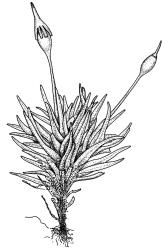- = Brachysteleum Rchb., Consp. Regn. Veg. [H.G.L.Reichenbach] 34 (1828)
Plants mostly dark green, forming cushions or turves, mostly on rock. Stems erect, often branched, in cross-section with a central strand. Leaves oblong- or ovate-lanceolate, spreading when moist, crisped when dry, not sheathing, entire or coarsely toothed, acute, obtuse, or rounded at apex, concave or keeled, usually with bistratose laminal patches, sometimes ± plicate; margins plane or incurved, often bistratose; mid laminal cells mostly rounded quadrate, often oblate in N.Z. species, firm-walled, incrassate, smooth or bulging; basal cells linear or oblong or ± quadrate, in N.Z. species rather thin-walled and slightly inflated; alar cells not differentiated. Costa percurrent, in cross-section with median guide cells and two stereid bands.
Autoicous. Perichaetial leaves somewhat enlarged but otherwise not differentiated. Perigonia on short branches below the perichaetia in the N.Z. species. Setae erect and straight or flexuose, single (as in N.Z. species) or multiple; capsules ovoid, ellipsoid, or cylindric; mouth transverse; annulus usually present (strongly differentiated in N.Z. species); exothecial cells firm-walled (as in N.Z. species) or sometimes ± thin-walled. Peristome single; teeth variously perforate or irregularly split into 2–3 papillose divisions. Calyptra mitrate but sometimes becoming cucullate with maturity, deeply lobed, plicate, covering c. ½ or the entire capsule. Spores spherical.
Ptychomitrium is a large genus of nearly cosmopolitan distribution. Sixty-two species were treated by Brotherus (1925, p. 8), while Wijk et al. (1967) accepted 80 species worldwide. Meagher (2017) has recently provided a treatment for Australia in which he accepted three species.
According to the concepts of Meagher (2017, p. 50), P. australe differs from the Australian P. acutifolium Hook.f. & Wilson [Bot. Antarct. Voy. III. (Fl. Tasman.) Part II: 180, 1859] by having leaves that are shouldered when wet, with more bluntly acute apices, and leaf lamina wholly bistratose above the leaf shoulder. By contrast the latter species has leaves that taper uniformly from the base to the apex (lacking a distinct shoulder), with more narrowly acute apices, and bistratose regions of the upper lamina that are confined to the margins and scattered longitudinal rows or patches.
Meagher’s characters (particularly with regard to the presence/absence of a shoulder) are difficult to apply to N.Z. material. The bulk of N.Z. material of P. australe has upper laminal cells (c. 1 mm below the apex) nearly all bistratose (but sometimes with an "isthmus" of unistratose cells adjacent to the costae, as illustrated in Image: Image\2SDD, Fig. H). No N.Z.material has been seen that matches Meagher’s concept of P. acutifolium, although aberrant material of P. australe is discussed below.
Meagher referred a single collection, made by G.A.M. Scott on the Queenstown–Arrowtown road in 1966, to P. acutifolium. This collection has not been available for study. However, Meagher’s suggestion (p. 56) that "most reports of P. australe from New Zealand are likely to be P. acutifolium" is not supported here and P. acutifolium is neither accepted as part of the N.Z. flora nor discussed further here.
| Category | Number |
|---|---|
| Indigenous (Non-endemic) | 1 |
| Total | 1 |




